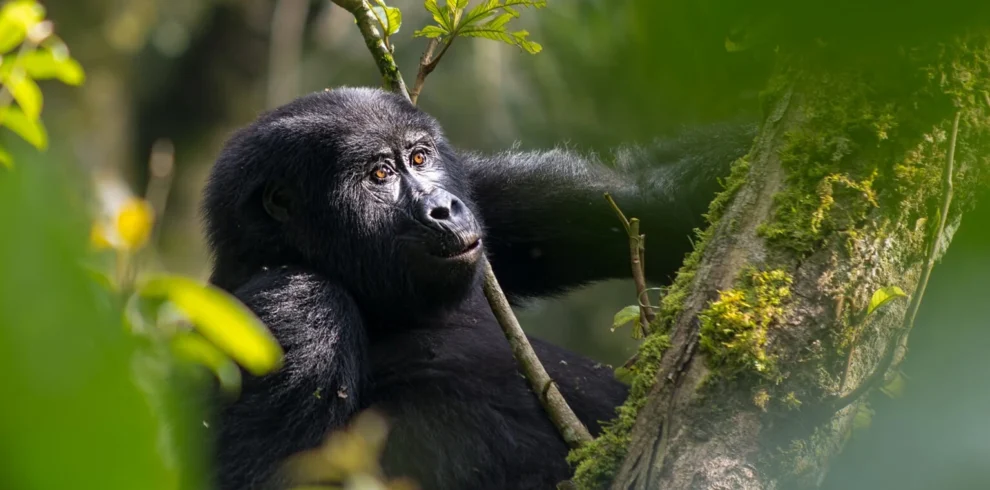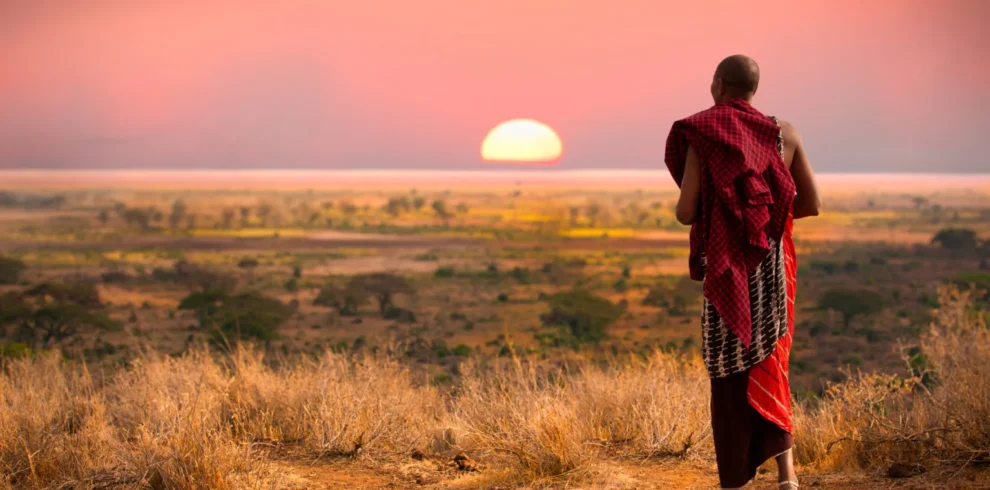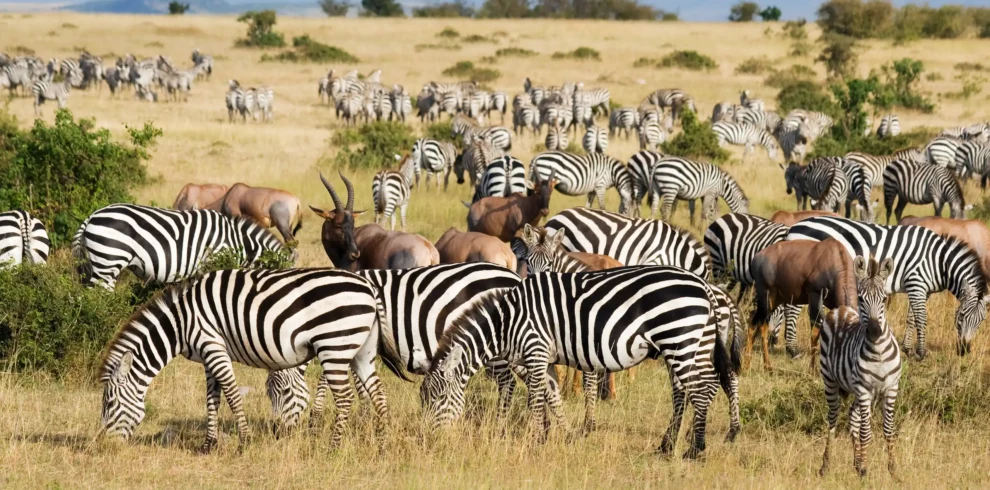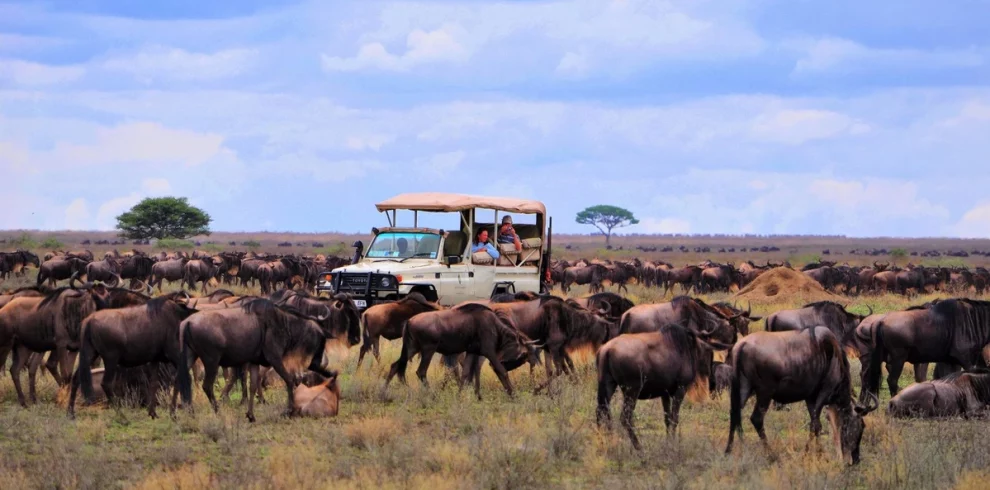Our expertly crafted wildebeest migration safari packages allow you to witness the greatest wildlife spectacle on Earth. Known as the Serengeti Migration and the Masai Mara Migration, the Great Wildebeest Migration is one of the last mass terrestrial wildlife movements remaining on Earth.
The Great Migration is also one of the Seven Natural Wonders of Africa and the primary reason many travelers choose to visit Tanzania and Kenya for their African safaris.
Each year, up to two million wildebeests, zebras, and gazelles gather their young and embark on a 3,000-kilometer journey, guided by the rains and their ancient instincts. They travel through the Serengeti National Park in northern Tanzania and the Masaai Mara in western Kenya. Along the way, the migrating herds face numerous challenges as they move from region to region, constantly under threat from predators like lions, hyenas, and cheetahs, as well as crocodiles waiting at various river crossings. It is a truly epic drama.
what is wildebeest migration?
The Great Wildebeest Migration is the largest overland animal migration in the world. Every year, about 2 million wildebeests and zebras migrate in a clockwise direction across Serengeti in Tanzania and Masai Mara in Kenya in search of nutritious grass to graze and water to drink.
Guided by survival instinct, these animals travel 800 to 1000km during each cycle. Hungry predators like crocs, lions, cheetahs, and hyenas make sure only the strongest survive in this unforgettable natural spectacle also known as ‘the greatest wildlife show on Earth. The herds move constantly in a clockwise direction as the seasons progress, up from the south of the Serengeti, through the Ngorongoro Conservation Area (although not into the Ngorongoro Crater itself), the Loliondo Game Controlled Area, and the Grumeti Reserve.
They then depart Tanzania briefly to spend time in Kenya’s Maasai Mara National Reserve, which borders Serengeti to the north, before heading back south to begin the journey again. Most of the migration happens in the far larger Serengeti Park than in Maasai Mara. While there are annual migration patterns, the exact timing of migration varies based on rainfall. Following this journey can be a bit trickier than your typical safari, and knowing when to be where is important as the animals are continually on the move.
What month is the wildebeest migration?
The migration doesn’t only occur between July and October. It is actually an ever-moving, circular migration with several but equally thrilling events that occur year-round.
The first few months of the year offer travelers exceptional predator sightings in Serengeti as this is the calving season for the wildebeest and newborns make for easier targets. By July, the animals are traveling north into the central Serengeti where they make their first river crossing, and take their chances against the waiting giant crocodiles. In August, the wildebeest cross Mara River into the Masai Mara Reserve.
Towards the end of the year, the animals move southwards back into the Serengeti National Park where they brace themselves for the next calving season and predator attacks.
Where does the wildebeest migration start?
The migration has no defined start or end points. But after calving in the southern part of Serengeti, the animals move through the Serengeti up and around in a clockwise direction. They move towards the Masai Mara before returning once again near the end of the year.
Why do wildebeest migrate?
The seasonal rains and the search for green grass drive wildebeest to migrate. When the dry season arrives in an area and water and food supplies decline, animals migrate, essentially following a natural instinct to find to food to stay alive. Some say that the wildebeest migration is triggered by distant lightning and thunderstorms, but there is no scientific proof of it.
How does Great wildebeest migration work?
The long and short rainy seasons in Kenya and Tanzania that were once predictable in Kenya and Tanzania are now unpredictable due to climate change. The rainfall can be late or early, which will throw the entire wildebeest migration calendar out of synch. This is why it is crucial to plan for as much time on safari as possible. You cannot fly in for 2-night safari, see the Mara River crossing and fly out again – nature simply doesn’t work that way. Below is just a very general guideline for where the herds are during the year. You should bear in mind that the entire Wildebeest Migration is prompted by rain, which can be early, late, or on time:
1. Wildebeest Migration From December to March (calving season)
The first rains in the short grass plains of southern Serengeti beckon the enormous migratory herds of wildebeest and zebra. They then move slowly from southeast to southwest to Ndutu area, Ngorongoro Conservation Area and Maswa Game Reserve over this period.
Numerous females in the herd give birth in February – which is why nutritious grass is of top priority. Every year around, 500,000 wildebeest are born on the Serengeti plains. February is the month with the highest birthing rate, sometimes seeing as many as 8,000 born each day.
This calving season means adorable shaky babies finding their legs – a bonus for predators which enjoy a bounty of easily-caught food. Having the babies in tow implies the herd move a bit slower.
2. Wildebeest Migration from April to May (‘long rains’)
After bearing their young, the herds start to drift northward from the Ndutu region toward the fresher grass of the central Serengeti.
The herds have now split into large groups rather than the massive concentrations that stretch as far as the horizon. As the calves get bigger and stronger, the distances the animals cover gets longer as they move towards Lake Magadi in central Serengeti National Park.
April to May is also mating season of wildebeest in the Serengeti.
Male wildebeest madly dash about rounding up females and chasing off other males. Male bulls establish frequent mobile territories (no more than 100 feet in diameter) and each one attempts to retain as many passing cows as possible.
Territories may be retained for only a few crazed hours as the great herds are constantly on the move. The noise and commotion of over ½ million bulls grunting and clashing horns can be overwhelming.
Note: This is the ‘long rains’ season, and you will need your rain jacket.
3. Great Wildebeest Migration in June (heading north)
By June, the rains have decreased slightly and the herds have spread out. Around this time, the front-runners reach Mbalageti River. However, others who are trailing behind could still be as far back as Lake Magadi or in the southernmost corner of the Simiti and Nyamuma Hills. As they go north, the herds are now frequently seen in long lines.
4. Great Migration in July (Grumeti River crossings)
In July, you can find the herds in the Grumeti portion of western Serengeti. Crossings of the Grumeti River are worth hanging around for. But the Serengeti is vast and relatively under-developed with lodges. So Grumeti River crossings are harder to find.
5. Great Migration from August to October (Mara River crossing)
By August the migrating herds have made their way up to the northern Serengeti and face their biggest challenge yet: the Mara River.
This fast-flowing river flows through the Maasai Mara National Reserve into the Serengeti National Park. And while the torrential murky waters are captivating, they are also perhaps responsible for the highest death toll en route, killing many thousands of wildebeest.
Sometimes the herds plunge en masse off steep banks in their desperate attempts to get across the river or after being spooked by lions, and the fall alone will kill many individuals.
Others drown as they are crushed by the sheer volume of panicking wildebeest trying to scramble up the equally steep banks on the other side.
Every death means dinner for crocodiles birds and fish – such is nature’s bounty. During August to mid-October, the herds move back and forth over the Mara River – in both the Serengeti and Maasai Mara – tending in an easterly direction.
By late October, most herds are packed into the eastern Maasai Mara National Reserve.
6. Wildebeest Migration in November (the ‘short rains’)
Early rains in November prompt another move as the herds leave the now denuded grasslands of the Masai Mara and head back south into the rejuvenated Serengeti in the western area of Loliondo and Lobo. At this point, the herds establish themselves into smaller family units.
Best Time to Go on a Wildebeest Migration Safari
Now that you know how the African Great Wildebeest Migration in Kenya and Tanzania works, you can easily see that the best time to go depends entirely on which events you’re personally interested in witnessing. Don’t forget that, Masai Mara and Serengeti’s abundance of wildlife and wide open landscapes make them fantastic year-round Africa safari destinations.
Please Note: the above are estimated dates only. The Great Wildebeest Migration is a year-round, circular move of animals and the wildebeest river crossings cannot be foreseen. Sometimes the animals stay put for two weeks, other times they could cross four times in one day!
Key Facts About Wildebeest Migration
- Most of the Migration happens in the Serengeti National Park,
- The Great wildebeest migration is a year-round, circular journey.
- River crossings cannot be foretold, but usually occur between July and October
- The animals are strung out across a large area – there are always fore-runners and stragglers.
- Your best chance of seeing the Mara river crossing may involve spending all day at a site where the wildebeest have massed. If you are a keen photographer, your best opportunities may occur around midday when the sun and glare are at their harshest, so make preparations to accommodate this.
Ready to Plan Your Wildebeest Migration Safari?
Best Places to stay on a Wildebeest Migration Safari
Accommodation for Wildebeest Migration safaris can be divided into two broad categories: mobile safari camps and permanent lodges. Each has different advantages, but choosing one depends on what you are interested in:
Mobile Safari Camps
- En suite tents with flush toilets
- Usually bucket showers
- Basins may use jug water
- There may not be running water
- Some don’t have Wi-Fi
Permanent Lodges
- En suite with hot-and-cold running water
- Plumbed showers
- Flush toilets
- Maybe bathtubs
- Maybe outdoor showers
- Usually have Wi-Fi
- Solar and generator electricity
- In-room Charging facilities
Tips for Choosing Wildebeest Migration Safari Accommodation
- Book early in advance as lodges and camps are small and fill up very quickly.
- If you need inter-connecting tents or family suites, book as early as possible as few are available.
- If you are travelling with very young children, book fenced accommodation, babysitting services and your own private game-drive vehicle.
- If you have mobility issues, ask for rooms near mess areas to avoid long walks, often on soft sand.
- If you are a budget traveler, choose good-value accommodation so that you have extra time on safari. This increases your chances of witnessing births, kills or crossings.
How To avoid the crowds during the Great Wildebeest Migration Safari?
Unfortunately, Mara River crossings months of the Great Wildebeest Migration safari can be crowded. All of the river crossings take place in the public areas of the Maasai Mara and Serengeti National Parks. This implies that they are accessible to everybody that has a safari vehicle and pays their park fees – including self-drive tourists and day-trippers.
Even if your selected safari accommodation is in a private concession bordering the parks, you’ll still have to join the masses of vehicles at the river crossing points if you wish to witness the drama of this epic natural phenomenon. To avoid the crowds during your Wildebeest Migration safari, you have three options:
- If want to see Mara River crossings but are not keen on the crowds of the prime safari season (August and September), then October is your best bet – although leaving it beyond mid-October risks not seeing any river crossings.
- Grumeti River crossings occur during July – but note that the Grumeti River is smaller than the Mara River and has many dry crossing points. This means that Grumeti River crossings are not as dramatic. Also, the Grumeti area is more remote, and crossings are more difficult to find.
- Enjoy the other aspects of the Great Migration – away from the Mara River crossings. The calving period in southern Serengeti is spectacular if you want to see massive herds and cute babies – and predators snacking on the bounty. Any month is a good month during the Great Migration, and you will find unique, epic experiences no matter when you come on safari.
Augment Your Wildebeest Migration Safari
The Masai Mara National Reserve and Serengeti National Park combine easily with each other, and each can also form the focal point of a larger safari itinerary.
We recommend combining the Masai Mara with Amboseli National Park, Lake Nakuru National Park, Samburu National Reserve, Mombasa and Laikipia Plateau region, or adding Tarangire National Park, the Ngorongoro Crater, Lake Manyara National Park and Zanzibar to the Serengeti safari. You can even go further afield and easily add other top Africa safari destinations like:
- Uganda or Rwanda for the world’s best wild gorilla-trekking and chimpanzee tracking experiences.
- Seychelles or Mauritius for stunning tropical beaches and fantastic diving locations.
Ready to Plan Your Wildebeest Migration Safari?
Get in touch with one of our East Africa Safaris Experts to help customize a Wildebeest Migration safari package based on your travel interest and budget:




